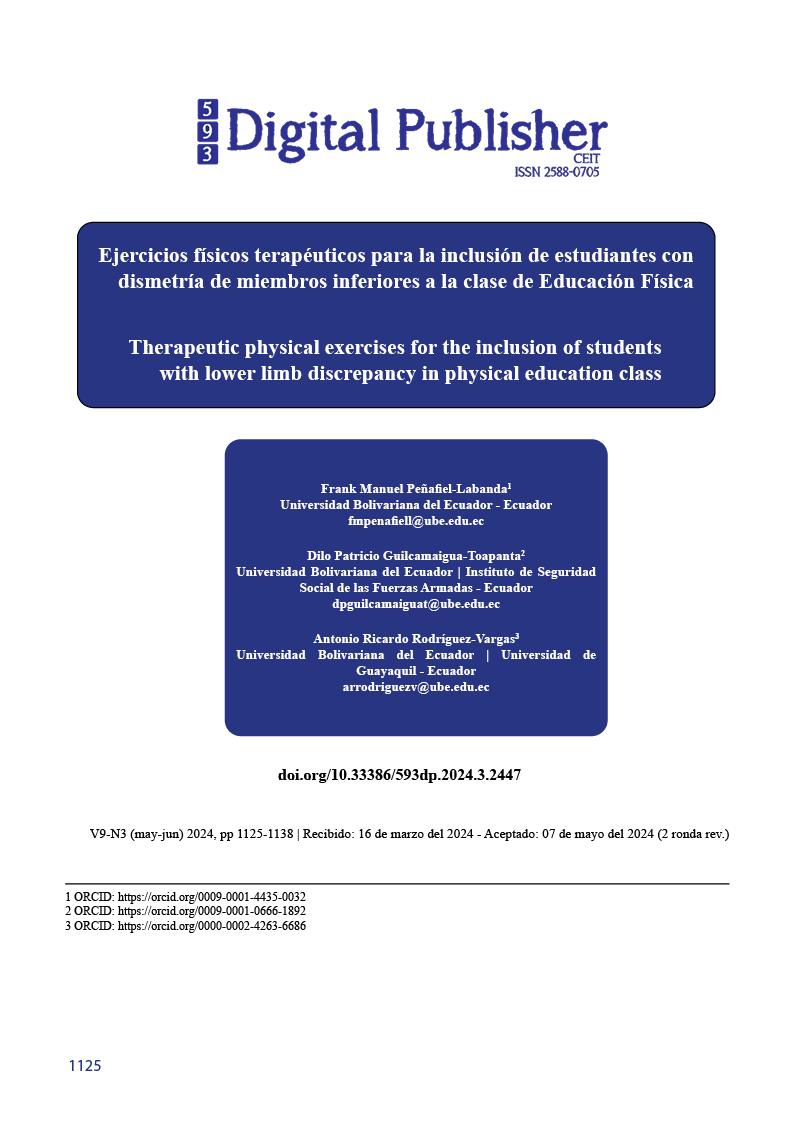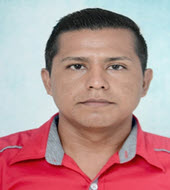Therapeutic physical exercises for the inclusion of students with lower limb discrepancy in physical education class
Main Article Content
Abstract
The present study was developed with the objective of designing a program of therapeutic physical exercises for the inclusion of students with lower limb dysmetria in the Physical Education class. The research design for the validation of the proposal was based on a mixed research approach, applying a pre-experimental intervention and a phenomenological design for systematization of experiences. The study sample was 13 students from a parallel group made up of 12 conventional students and 1 student with a diagnosis of dysmetria in their lower limbs, who presents a certain degree of difficulty in performing physical exercises and maintains full independence during their daily care. Observation was the quantitative technique applied, through a Pre and a Post-test during the application of the proposal to determine the degree of educational inclusion. The didactic strategy was based on the implementation of therapeutic physical exercises, taking into account their level of motor ability, coordination and resistance, in a differentiated way that takes into account the interests, motivations and expectations of the enjoyment of performing the physical exercises. The results of the pre-experiment allowed us to identify an improvement to 96% of acceptance and satisfaction for performing physical exercises, compared to the 32% that the student demonstrated at the beginning, in addition, recommendations were issued for its planning, execution and monitoring, evidencing the validity of the designed proposal. It is concluded that the program contributes to the inclusion of students with lower limb dysmetria in Physical Education classes effectively, which is recommended to be applied by teachers for inclusive and well-being purposes.
Downloads
Article Details

This work is licensed under a Creative Commons Attribution-NonCommercial-ShareAlike 4.0 International License.
1. Derechos de autor
Las obras que se publican en 593 Digital Publisher CEIT están sujetas a los siguientes términos:
1.1. 593 Digital Publisher CEIT, conserva los derechos patrimoniales (copyright) de las obras publicadas, favorece y permite la reutilización de las mismas bajo la licencia Licencia Creative Commons 4.0 de Reconocimiento-NoComercial-CompartirIgual 4.0, por lo cual se pueden copiar, usar, difundir, transmitir y exponer públicamente, siempre que:
1.1.a. Se cite la autoría y fuente original de su publicación (revista, editorial, URL).
1.1.b. No se usen para fines comerciales u onerosos.
1.1.c. Se mencione la existencia y especificaciones de esta licencia de uso.
References
Bernate, J. (2021). Educación Física y su contribución al desarrollo integral de la motricidad. Podium, Revista de Ciencia y Tecnología en la Cultura Física, 16(2), 643-661. Obtenido de http://scielo.sld.cu/scielo.php?script=sci_arttext&pid=S1996-24522021
Christopher, H. W., & Gerety, E. L. (2019). Leg length measurement: The discrepancy and beyond. (págs. C-1654). European Congress of Radiology. doi:doi:https://dx.doi.org/10.26044/ecr2019/C-1654
Cobo, V., & Chuchico, A. (2020). Evaluación fisioterapéutica en aparente discrepancia en la longitud de los miembros inferiores. Ciencias de la Salud. Ambato: Universidad Técnica de Ambato. Obtenido de https://repositorio.uta.edu.ec/jspui/handle/123456789/30974
De Pablos, J. (2015). Dismetría de los miembros inferiores. MBA INSTITUTE(13). Obtenido de http://www.mbainstitute.eu/recursos/boletines/12mk075-boletin-mba-institute-bo13-150ppp.pdf
García, C. (2014). Dismetría de extremidades inferiores. Obtenido de https://www.traumatologiainfantil.com/es/piernas/dismetria-de-extremidades
Global Partnership for Education. (2018). Results Report 2018. Obtenido de https://www.globalpartnership.org/sites/default/files/2018-06-gpe-results-report-2018-web4.pdf
Loarte, C. (. (2022). Relación entre dismetría de miembros inferiores y escoliosis idiopática en niños de un hospital de Lima, 2022. Universidad Nacional Mayor de San Marcos., Lima. Obtenido de https://hdl.handle.net/20.500.12672/19208
López, J., Alemón, B., & Huegel, J. (2021). Dismetría y características posturales en personas con amputación de extremidad inferior y análisis de su alineación protésica., 8, págs. 240-244. doi:doi:dx.doi.org/10.24254/CNI
Martínez, R., Baño, A., García, J., Belando, M., Martínez, Á., & Belmonte, A. (2020). Correlación entre la dismetría, reparto de carga y alteraciones estructurales del miembro inferior. Revista EJPOD, 6(1). doi:doi:https://doi.org/10.17979/ejpod.2020.6.1.5726
Osmani, F. (2022). Relación entre la dismetría de los miembros inferiores y el índice de asimetría en el pedaleo en ciclistas no profesionales. MLS Sport Research, 2(1), 1-17. doi:doi: 10.54716/mlssr.v2i1.921
Rivera, M. (2022). Relación entre displasia del desarrollo de cadera y dismetría de miembros inferiores en infantes de la Clínica San Juan de Dios Arequipa 2021. Arequipa: Universidad Continental. Obtenido de https://repositorio.continental.edu.pe/bitstream/20.500.12394/12010/2/IV_FCS_507_TE_Rivera_Chullo_2022.pdf
Rodríguez, A. (2018). Efectividad del tratamiento ortopodológico en la sintomatología de las dismetrías del miembro inferior. Universidade da Coruña. Obtenido de http://hdl.handle.net/2183/23851
UNESCO. (2020). Informe de seguimiento de la educación en el mundo, 2020: Inclusión y educación: todos y todas sin excepción. París, Francia: UNESCO. Obtenido de https://unesdoc.unesco.org/ark:/48223/pf0000374817
World Health Organization, WHO. (2018). Family Planning . Obtenido de World Health Organization.: https://apps.who.int/iris/bitstream/handle/10665/260156/9780999203705-eng.pdf?sequence=1




